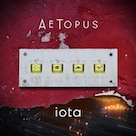

AeTopus: iota
Spotted Peccary Music
Something of an old-school electronica vibe is exuded by iota, Bryan Tewell Hughes' second AeTopus release for Spotted Peccary Music, that enhances the recording's appeal. Gear details aren't clarified on the album sleeve, but the aural evidence suggests he's used analog devices as much as digital ones, resulting in tracks that are warm, slightly nostalgia-laden, and breathe humanity. Before committing himself to ambient and electronic music, he immersed himself in heavy metal, industrial, and punk, and even though such genres don't surface on iota his time spent with them invariably factored into the music he's creating now.
Hughes' mini-bio indicates that he generates his material out of his Bellingham, Washington-based studio using analog and digital synthesis, percussion, field recordings, and found objects. It also reports that early on he studied classical piano, has operated as an independent artist for many years, and issued seven albums and two EPs before joining Spotted Peccary and releasing 2023's Cup. He's an experienced hand at this sort of thing, in other words, and the skills he's developed as a sound designer and crafter of atmosphere, melody, and intricate beat structures are clearly evident on the new release.
“Museum” sets the tone when twilight sparkle and ambient washes blossom into a restless, pulsating mass, all flickering flourishes, tap-tapping percussion, and churning arpeggiations. Much like a prototypical Slow Dancing Society production, AeTopus's conjures a night-time realm pulsating with activity, excitement, and possibility. Less agitated by comparison, "Why Not Now” percolates calmly, with silken tones expanding and contracting like some sleeping entity and the material oozing mystery. Dub isn't listed as an AeTopus influence, but the atmospheric multi-dimensionality of the production suggests it could be. While the two tracks are obviously different in tempo and tone, both include moments that evoke Tangerine Dream circa '74. Meanwhile, “Finespun,” animated by swirling synth patterns and convulsive rhythms, could pass for some imaginary ‘90s collaboration between Aphex Twin and Vladislav Delay.
An ominous, ground-shaking drone introduces “Tell_us” until the smoke clears and a jittery beat emerges, with noises sweeping across the stereo field like the helicopters flying across the soon-to-be-immolated landscape at the start of Apocalypse Now. A rather more hopeful tone informs “Probe” when it casts its contemplative gaze skyward in the hope of receiving transmissions from distant friends. As drenched in synthesizer timbres and sequencer patterns as it is, “Level” also includes hand drums, a detail that, as mentioned, amplifies Hughes' music's natural, non-synthetic dimension. The same could be said of “Subsystem” when organ and tablas emerge alongside dramatic long-form synthesizer swirls.
Each of the twelve twinkling tracks paints a detailed picture for four to six minutes at a time, and Hughes is smart enough to know when a piece should make its exit. Sound design, mood-building, and production are clearly as important to an AeTopus piece as rhythm and melody, which makes iota one of those albums that benefits greatly from an enhanced playback setup. Dim the lights, sit back, and turn it up for the music to have its greatest impact.May 2025